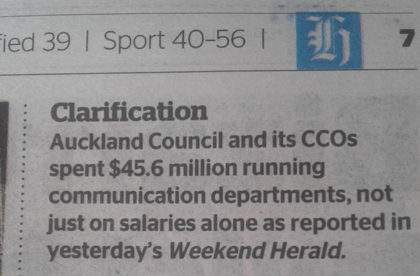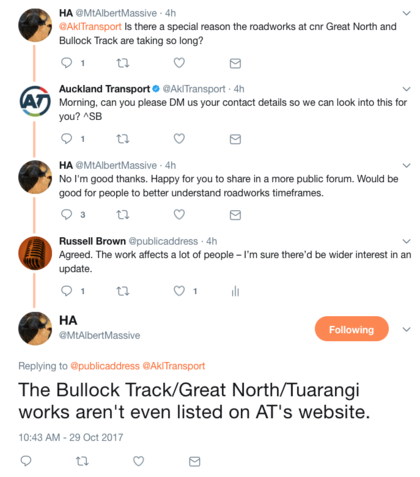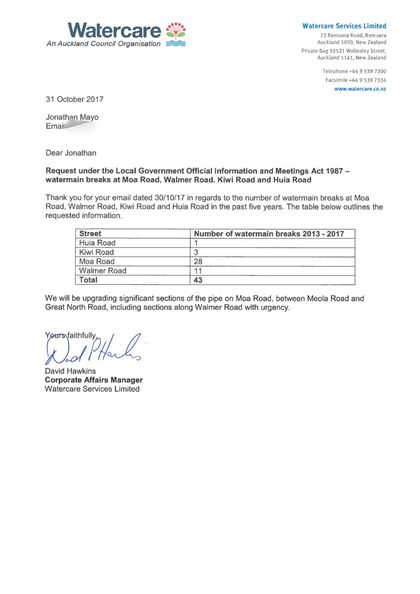About 5am yesterday, I got out of bed to fetch a drink of water from the tap and noticed that there was not much water to be had. "Bugger," I thought, watching a thin stream trickle into the glass, then drank it and went back to bed, expecting that by the time we got up for breakfast the water would be right off. It was.
Point Chevalier might be hot in the real estate market, but its infrastructure is, in places, well past best-before date. Electricity goes out for various reasons several times a year. It was a huge relief to be able to farewell the old paper-insulated copper network when fibre came to our street last year. (We lost internet for nearly two weeks once when a Watercare digger broke a pipe, flooded Chorus's duct and got the paper all wet.) A fix for the water network is taking a little longer.
The ageing main that runs up the east side of Moa Road started breaching maybe five years ago, and every time it does, it's basically the same: water bursts through the grass verge and floods, a couple of Watercare trucks eventually arive, the "Oasis" trailer dispenses big bottles of water to anyone who asks – and no one knows what the hell is going on.
Watercare Services has no social media presence, even on weekdays, so there's no one to ask on the internet. The contact page on the Watercare website says "In an emergency, check our updates page," which invariably has no updates. There's a free text service, which my partner tried. It came back with this hilarious message:
Thank you for your text. We will respond to your fault enquiry within an hour between the hours of 8am - 5pm Monday to Friday. Please call us 09 442 2222 if it's outside these hours.
Yes, it really does say they'll respond within an hour – just as soon as everyone's back in the office tomorrow. And while the date stamp on the reply is 8.55am, it did not actally arrive until after 1pm. We're still waiting for an actual reply.
To be fair, there is a phone number there on the page, and an operator did answer – but even she had to go away and ask for an answer to my question as to when we might be enjoying the benefits of running water. She said 1.30pm, but when I poppped around the corner at 1.30, Watercare's latest hole was still a hole.
I engaged one of the chaps on site and he said he thought they weren't too far off. I asked him when Watercare might just cut to the chase and replace the whole, crumbling pipe down the east side of Moa Road, he said he thought we might have a fix before too long: "But you didn't hear that from me."
To be fair, we don't hear that from anyone. When I first started complaining on Twitter about Watercare's inability to communicate a couple of years ago, they actually sent a chap around to see me personally and show me some maps. When I pointed out to him that this wasn't a very efficient way to communicate with the public, he agreed.
He explained that although the Moa Road main was breaching regularly, it had not met Watercare's benchmark formula for replacement. But a short part of the main was in the work schedule for the following year. This short stretch was indeed replaced, and the laws of physics being what they are, the pipe soon started breaching further up the road.
Another local resident, Jonathan Mayo, has a similar story. He was put in touch with a Watercare engineer after complaining to Peter Haynes, the chair of the Albert Eden local board. The engineer told him on October 19 that there would be a new main in the first half of next year – but on the west side.
In the 10 days since the email there have been two breaches on Moa Road and one around the corner in Walmer. Jonathan has filed a LGOIMA request to find out how many times in the past five years repair crews have been dispatched to our neighbourhood.
Now, okay, maybe we just have to wait. But the fact that this fairly important information seems to be shared exclusively in private conversations between Watercare engineers and those of us who complain sufficiently loudly is farcical.
And yet, according to Bernard Orsman in the Herald, Watercare is a champ at communications precisely because it spends so little money communicating:
Salary costs rose by 104.5 per cent at Panuku Development Auckland, which was formed in September 2015 from the merger of Waterfront Auckland and Auckland Council Property Ltd.
By comparison, salary costs at one of the biggest CCOs, Watercare, rose by a modest 8.5 per cent over four years. Watercare has a small FTE team of 8.5 communications staff.
Simon Wilson addresses the Herald story at The Spinoff this morning, in a column that opens thus:
The water went off in parts of Auckland yesterday. But Watercare didn’t post anything about it on its website and it put out no information on social media because, incredibly, it doesn’t do social media. Watercare made almost no effort to tell its customers what was going on.
Yes, that was us.
Wilson makes a point that always needs making: "communications" ≠ "spin doctors". It covers community consulation, council websites, mailers and the kind of information you'd expect to have if you and hundreds of others happened to lose running water.
He continues, in a section headed 'Watercare: The secrecy is scary':
Watercare, the council-controlled organisation that runs our water and sewage systems, has a comms budget of only $1.5 million, according to the review. But that’s not a good thing. Watercare has very few comms staff and it does little to engage. Internally at council, it doesn’t even bother to attend the regular meetings of council communications units, whose purpose is to help them all work together.
It’s not just problems like the water stoppage in Pt Chev this weekend. Remember the water crisis in March this year, when heavy rain silted up the Ardmore dam and the whole city was in danger of having to boil water? Watercare ignored offers of help from the council’s other comms units and engaged external PR consultants to help out. That led to lack of public information, inconsistencies in what we were told and other problems, all of which Todd Niall at RNZ covered here.
Yes, even during a citywide water quality crisis, Watercare, a council-controlled organisation, went out of its way to avoid conventional public communications. It did install an electronic sign up at the Meola Road roundabout to tell us all to save water. Wilson thinks this odd culture might be a legacy of Watercare's former CEO Mark Ford, who "famously kept as low a profile as he could manage, for himself and for the places he worked."
I'm often quite puzzled by what does and doesn't constitute a local story. Perhaps because it wasn't a public transport initiative, the multi-million-dollar bungle with the "dead" lane on the St Lukes interchange never seems to have registered as a headline. Treating the communications spending of the council and its various entities solely as something to be limited as far as possible doesn't make a lot of sense either.
I'm aware that budgets are limited and that there is a formula for prioritisting works, and, again, that maybe we do just have to wait. But it seems frankly absurd that both short and long-term information on something so basic as the security of our water supply should be so difficult to come by.
I guess that this post might earn me a personal communication from the Maintenance Planning and Development Engineer, as it did Joanthan. But I don't want that. I want all the relevant information compiled and published on a website where all the affected residents can read it. And when the east-side main breaches again, as it surely will, I'd like to be able to go to a Watercare social media account, or the Watercare website, and find relevant and timely information on the fault and when it's likely to be remedied. How hard could that be?


